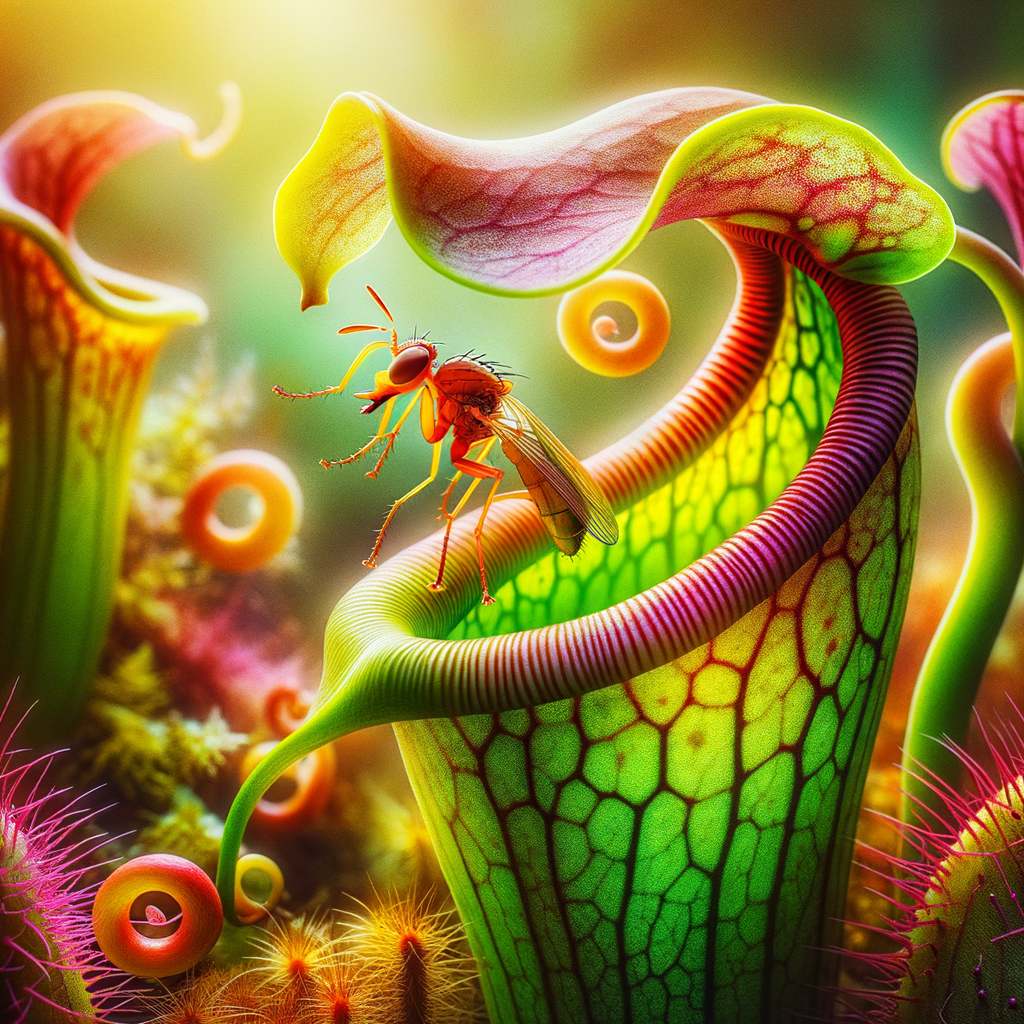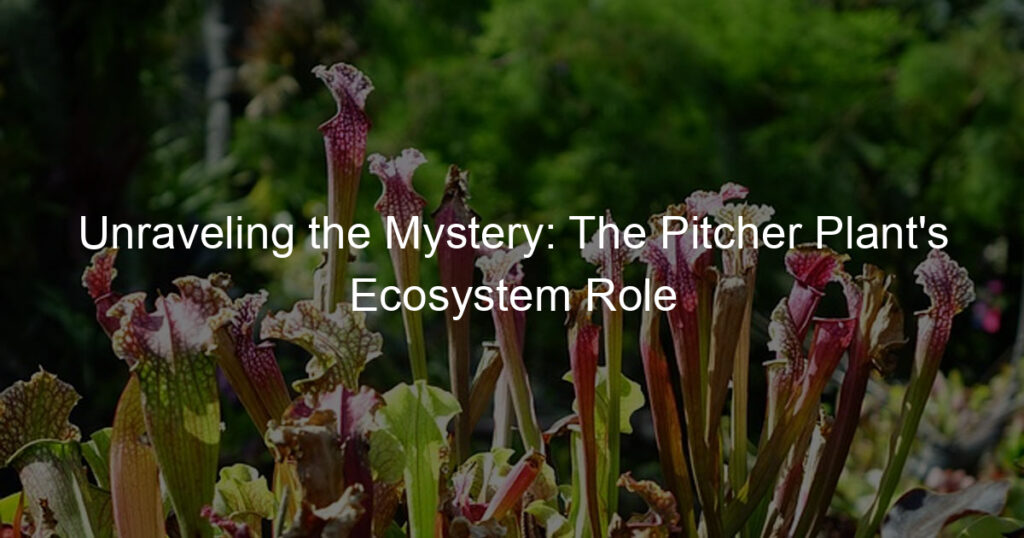
Introduction: The Fascinating World of Carnivorous Plants
Welcome to the intriguing world of carnivorous plants! These are not your everyday, run-of-the-mill plants. They have a unique feature that sets them apart – they eat insects and sometimes even small animals! Let’s dive in and learn more about these fascinating organisms.
- Understanding the concept of carnivorous plants
- Overview of different types of carnivorous plants
- Introduction to the Pitcher Plant
Carnivorous plants are a special group of plants that can catch and digest bugs and other small creatures. They do this to supplement their diet, as they often live in areas where the soil is poor in nutrients. They have developed various trapping mechanisms like sticky leaves, snap traps, and pitfall traps to catch their prey.
There are several types of carnivorous plants, each with its unique trapping mechanism. Some of the most well-known ones include the Venus Flytrap, the Sundew, and the Pitcher Plant. The Venus Flytrap uses a snap trap to catch its prey, while the Sundew has sticky leaves that trap insects. The Pitcher Plant, on the other hand, has a pitfall trap – a deep cavity filled with digestive fluid where the prey drowns.
The Pitcher Plant is one of the most fascinating carnivorous plants. Its name comes from the pitcher-like shape of its trap. The plant produces a sweet-smelling nectar that attracts insects. Once the insect lands on the plant, it slips and falls into the pitcher, where it drowns in the digestive fluid. The plant then absorbs the nutrients from the decomposed insect. Isn’t that fascinating?
So, there you have it – a brief introduction to the world of carnivorous plants. In the next section, we will delve deeper into the ecosystem of the Pitcher Plant. Stay tuned!
Understanding the Pitcher Plant Ecosystem
The Pitcher Plant, a fascinating carnivorous plant, plays a crucial role in its ecosystem. Let’s delve deeper into understanding this role.
Role of Pitcher Plant in the Ecosystem
The Pitcher Plant is not just a plant; it’s an essential part of the ecosystem. Here’s how:
- How the Pitcher Plant contributes to ecosystem balance
The Pitcher Plant helps maintain the ecosystem balance by controlling the insect population. By trapping and digesting insects, it prevents overpopulation of these species, which could otherwise harm the ecosystem. - Understanding the Pitcher Plant’s function
The Pitcher Plant has a unique function in the ecosystem. It’s a carnivorous plant, meaning it feeds on insects. The plant has a specialized structure, a ‘pitcher,’ filled with digestive fluid. When an insect lands on the plant, it slips into the pitcher and is digested by the fluid, providing nutrients to the plant. - Examples of Pitcher Plant’s impact on its surroundings
The Pitcher Plant’s impact on its surroundings can be seen in two main ways. Firstly, it helps control the insect population, contributing to a balanced ecosystem. Secondly, it provides a source of nutrients for other organisms. For example, certain species of mosquito larvae are known to thrive in the water-filled pitchers, feeding on the plant’s leftovers.
Understanding the role of the Pitcher Plant in the ecosystem helps us appreciate the intricate balance of nature. Each organism, no matter how small, plays a part in maintaining this balance.
Predator Plants: The Pitcher Plant’s Predation
- How the Pitcher Plant traps its prey: The Pitcher Plant uses a unique method to catch its prey. It secretes a sweet-smelling nectar that attracts insects. Once the insect lands on the plant, it slips into the plant’s “pitcher” due to the slippery surface. Unable to climb out, the insect is then digested by the plant’s enzymes.
- Types of prey in the Pitcher Plant’s ecosystem: The Pitcher Plant mainly feeds on insects such as ants, beetles, spiders, and even small frogs. These creatures are abundant in the plant’s ecosystem, providing it with a steady food source.
- Impact of this predation on the ecosystem: The Pitcher Plant plays a crucial role in controlling the insect population in its ecosystem. This helps maintain a balance, preventing any one species from becoming too dominant and disrupting the ecosystem.
- Overview of the rainforest ecosystem: The rainforest is a complex and diverse ecosystem, home to a wide variety of plants and animals. It is characterized by high rainfall and humidity, making it an ideal environment for the Pitcher Plant.
- Role and impact of the Pitcher Plant in this setting: In the rainforest, the Pitcher Plant contributes to biodiversity and helps control insect populations. It also provides a source of nutrients for other organisms when its prey is digested.
- Overview of the wetland ecosystem: Wetlands are areas where water covers the soil or is present either at or near the surface of the soil. They are home to numerous species of plants and animals, including the Pitcher Plant.
- Role and impact of the Pitcher Plant in this setting: In wetlands, the Pitcher Plant helps control mosquito populations by trapping and digesting their larvae. This reduces the risk of diseases spread by mosquitoes.
- Importance of each organism in maintaining ecosystem balance: Every organism in an ecosystem plays a role in maintaining balance. For example, predators control the population of prey species, while plants provide food and oxygen for other organisms.
- Examples of other plants and their roles in the ecosystem: Other plants, like trees, provide shelter for animals and help regulate the climate by absorbing carbon dioxide. Grasses prevent soil erosion by holding the soil together with their roots.
- How understanding the Pitcher Plant can help us understand other ecosystems: Studying the Pitcher Plant can give us insights into how organisms adapt to their environment and interact with other species. This can help us understand the dynamics of other ecosystems as well.
- Recap of the Pitcher Plant’s function and impact: The Pitcher Plant is a unique predator that helps control insect populations in its ecosystem. It contributes to biodiversity and provides nutrients for other organisms.
- Key takeaways about the role of the Pitcher Plant in the ecosystem: The Pitcher Plant plays a crucial role in its ecosystem by controlling insect populations, contributing to biodiversity, and providing nutrients for other organisms.
- Final thoughts on the importance of understanding ecosystem roles: Understanding the roles of different organisms in an ecosystem is crucial for conservation efforts. It helps us appreciate the importance of each species and the consequences of disrupting the balance.








